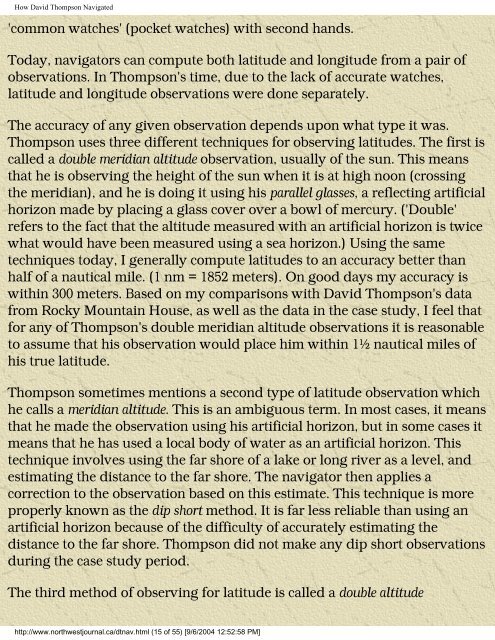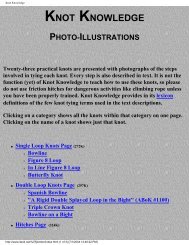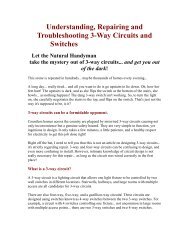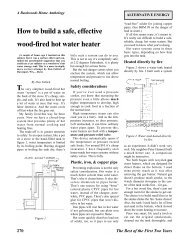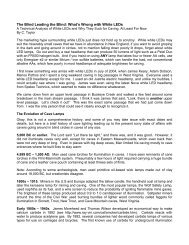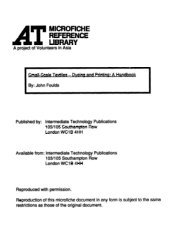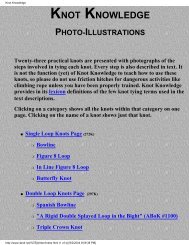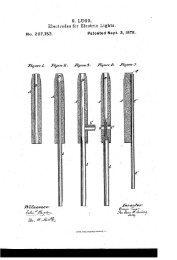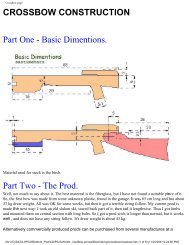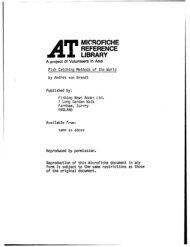- Page 1 and 2:
Celestial Navigation Net Break out
- Page 3 and 4:
July A Poem in Defense of Lunars Th
- Page 5 and 6:
Recent Additions NEW!!! The "Land a
- Page 7 and 8:
Recent Additions Celestaire's Cardb
- Page 9 and 10:
Search by keywords A Message from t
- Page 11 and 12:
Why Celestial Navigation? Why Celes
- Page 13 and 14:
Why Celestial Navigation? Perspecti
- Page 15 and 16:
History Seaman's Secrets online. A
- Page 17 and 18:
Navigational Astronomy EINSTEIN WAS
- Page 19 and 20:
Theory Theory teering by the stars,
- Page 21 and 22:
Theory Finding latitude by Polaris,
- Page 23 and 24:
Practice without him? - Omar Reis's
- Page 25 and 26:
Practice your assumed position). 7.
- Page 27 and 28:
Practice Amazon.com and you'll see.
- Page 29 and 30:
Celnav in the Classroom children in
- Page 31 and 32:
Celnav in the Classroom Why isn't t
- Page 33 and 34:
Celnav in the Classroom ● Latitud
- Page 35 and 36:
The Vikings ● Viking Navigation f
- Page 37 and 38:
Navigational Instruments the horizo
- Page 39 and 40:
Navigational Instruments vertical s
- Page 41 and 42:
http://www.celestialnavigation.net/
- Page 43 and 44:
Quotations Quotations "Navigation i
- Page 45 and 46:
Quotations all men in their degree,
- Page 47 and 48:
Quotations Joseph Conrad on death..
- Page 49 and 50:
Quotations St. Paul before his ship
- Page 51 and 52:
Quotations • Home • Why Celesti
- Page 53 and 54:
SCHOOLS Liveaboard courses on the S
- Page 55 and 56:
Resources African Star Lore How A S
- Page 57 and 58:
Resources TUTORIALS AND SUMMARIES U
- Page 59 and 60:
Resources Out of Print - Worth Look
- Page 61 and 62:
Other Links of Interest R. L. Cross
- Page 63 and 64:
This was formerly a direct mail lin
- Page 65 and 66:
Dante sailing, it was a marriage ma
- Page 67 and 68:
Land and Sea Collection Home NEW SE
- Page 69 and 70:
Land and Sea Collection varies bewt
- Page 71 and 72:
Starpath School of Navigation Title
- Page 73 and 74:
Amazon.com: Secrets of the Viking N
- Page 75 and 76:
Amazon.com: Line of Position Naviga
- Page 77 and 78: Amazon.com: Line of Position Naviga
- Page 79 and 80: CelestNav for PalmOS CelestNav TM r
- Page 81 and 82: CelestNav for PalmOS One Hundred Pr
- Page 83 and 84: Celestaire, Inc.: Cheap Sextant Pra
- Page 85 and 86: XTant project - Build your own sext
- Page 87 and 88: XTant project - Build your own sext
- Page 89 and 90: XTant project - Build your own sext
- Page 91 and 92: XTant project - Build your own sext
- Page 93 and 94: XTant project - Build your own sext
- Page 95 and 96: XTant project - Build your own sext
- Page 97 and 98: XTant project - Build your own sext
- Page 99 and 100: AstroNavPC and Compact Data 2001-20
- Page 101 and 102: AstroNavPC and Compact Data 2001-20
- Page 103 and 104: Sail the Sounds, ASA Sail Training
- Page 105 and 106: Sail the Sounds, ASA Sail Training
- Page 107 and 108: Sail the Sounds, ASA Sail Training
- Page 109 and 110: Sail the Sounds, ASA Sail Training
- Page 111 and 112: Sail the Sounds, ASA Sail Training
- Page 113 and 114: Sail the Sounds, ASA Sail Training
- Page 115 and 116: How David Thompson Navigated Messag
- Page 117 and 118: How David Thompson Navigated The Au
- Page 119 and 120: How David Thompson Navigated Maskel
- Page 121 and 122: How David Thompson Navigated 14).
- Page 123 and 124: How David Thompson Navigated has co
- Page 125 and 126: How David Thompson Navigated Using
- Page 127: How David Thompson Navigated freque
- Page 131 and 132: How David Thompson Navigated suspec
- Page 133 and 134: How David Thompson Navigated meet t
- Page 135 and 136: How David Thompson Navigated If the
- Page 137 and 138: How David Thompson Navigated Nov. 2
- Page 139 and 140: How David Thompson Navigated latitu
- Page 141 and 142: How David Thompson Navigated Find d
- Page 143 and 144: How David Thompson Navigated Find A
- Page 145 and 146: How David Thompson Navigated the sk
- Page 147 and 148: How David Thompson Navigated examin
- Page 149 and 150: How David Thompson Navigated distan
- Page 151 and 152: How David Thompson Navigated 62º 0
- Page 153 and 154: How David Thompson Navigated Findin
- Page 155 and 156: How David Thompson Navigated Figure
- Page 157 and 158: How David Thompson Navigated six ar
- Page 159 and 160: How David Thompson Navigated Angle
- Page 161 and 162: How David Thompson Navigated Vega 1
- Page 163 and 164: How David Thompson Navigated must l
- Page 165 and 166: How David Thompson Navigated Greenw
- Page 167 and 168: How David Thompson Navigated The va
- Page 169 and 170: How David Thompson Navigated Thomps
- Page 171 and 172: Nomad Electronics, Pocket Stars, Po
- Page 173 and 174: Nomad Electronics, Pocket Stars, Po
- Page 175 and 176: NOVA Online | The Search for Longit
- Page 177 and 178: NOVA Online | Teachers | Teachers'
- Page 179 and 180:
NOVA Online | Teachers | Teachers'
- Page 181 and 182:
NOVA Online | Teachers | Teachers'
- Page 183 and 184:
NOVA Online | Teachers | Teachers'
- Page 185 and 186:
NOVA Online | Teachers | Teachers'
- Page 187 and 188:
NOVA Online | Teachers | Teachers'
- Page 189 and 190:
NOVA Online | Teachers | Teachers'
- Page 191 and 192:
NOVA Online | Teachers | Teachers'
- Page 193 and 194:
NOVA Online | Shackleton's Voyage o
- Page 195 and 196:
NOVA Online | Shackleton's Voyage o
- Page 197 and 198:
Comparative Analysis Learning (Colu
- Page 199 and 200:
celestial navigation Introduction C
- Page 201 and 202:
celestial navigation navigation. Th
- Page 203 and 204:
celestial navigation Go back to the
- Page 205 and 206:
The Abaco Wild Horse Fund, Inc. Thi
- Page 207 and 208:
Heavenly Mathematics: Cultural Astr
- Page 209 and 210:
Heavenly Mathematics: Cultural Astr
- Page 211 and 212:
Heavenly Mathematics: Cultural Astr
- Page 213 and 214:
Heavenly Mathematics: Cultural Astr
- Page 215 and 216:
Heavenly Mathematics: Cultural Astr
- Page 217 and 218:
Heavenly Mathematics: Cultural Astr
- Page 219 and 220:
Heavenly Mathematics: Cultural Astr
- Page 221 and 222:
Heavenly Mathematics: Cultural Astr
- Page 223 and 224:
Heavenly Mathematics: Cultural Astr
- Page 225 and 226:
Heavenly Mathematics: Cultural Astr
- Page 227 and 228:
Heavenly Mathematics: Cultural Astr
- Page 229 and 230:
Heavenly Mathematics: Cultural Astr
- Page 231 and 232:
Heavenly Mathematics: Cultural Astr
- Page 233 and 234:
Heavenly Mathematics: Cultural Astr
- Page 235 and 236:
Heavenly Mathematics: Cultural Astr
- Page 237 and 238:
Heavenly Mathematics: Cultural Astr
- Page 239 and 240:
Heavenly Mathematics: Cultural Astr
- Page 241 and 242:
Heavenly Mathematics: Cultural Astr
- Page 243 and 244:
Heavenly Mathematics: Cultural Astr
- Page 245 and 246:
Heavenly Mathematics: Cultural Astr
- Page 247 and 248:
Heavenly Mathematics: Cultural Astr
- Page 249 and 250:
Heavenly Mathematics: Cultural Astr
- Page 251 and 252:
Heavenly Mathematics: Cultural Astr
- Page 253 and 254:
Heavenly Mathematics: Cultural Astr
- Page 255 and 256:
Heavenly Mathematics: Cultural Astr
- Page 257 and 258:
Heavenly Mathematics: Cultural Astr
- Page 259 and 260:
Heavenly Mathematics: Cultural Astr
- Page 261 and 262:
Heavenly Mathematics: Cultural Astr
- Page 263 and 264:
Aboriginal (Native American) Star K
- Page 265 and 266:
Aboriginal (Native American) Star K
- Page 267 and 268:
Aboriginal (Native American) Star K
- Page 269 and 270:
African Starlore African Starlore A
- Page 271 and 272:
African Starlore According to the N
- Page 273 and 274:
African Starlore ● The sky is sto
- Page 275 and 276:
African Starlore from the sky. Many
- Page 277 and 278:
Longitude at Sea Indies, finding lo
- Page 279 and 280:
Longitude at Sea timed eclipses and
- Page 281 and 282:
Northwest Journal Featured Articles
- Page 283 and 284:
Sun or Moon Rise/Set Table for One
- Page 285 and 286:
Sun or Moon Rise/Set Table for One
- Page 287 and 288:
Epact: Scientific Instruments of Me
- Page 289 and 290:
Amazon.com: Welcome Kids & Baby •
- Page 291 and 292:
The Haven The Haven-Finding Art: Th
- Page 293 and 294:
NOVA Online | The Search for Longit
- Page 295 and 296:
NOVA Online | The Search for Longit
- Page 297 and 298:
NOVA Online | The Search for Longit
- Page 299 and 300:
The Seamans Secrets - John Davis 16
- Page 301 and 302:
The Seamans Secrets - John Davis 16
- Page 303 and 304:
The Seamans Secrets - John Davis 16
- Page 305 and 306:
The Seamans Secrets - John Davis 16
- Page 307 and 308:
The Seamans Secrets - John Davis 16
- Page 309 and 310:
The Seamans Secrets - John Davis 16
- Page 311 and 312:
The Seamans Secrets - John Davis 16
- Page 313 and 314:
The Seamans Secrets - John Davis 16
- Page 315 and 316:
The Seamans Secrets - John Davis 16
- Page 317 and 318:
The Seamans Secrets - John Davis 16
- Page 319 and 320:
The Seamans Secrets - John Davis 16
- Page 321 and 322:
The Seamans Secrets - John Davis 16
- Page 323 and 324:
The Seamans Secrets - John Davis 16
- Page 325 and 326:
The Seamans Secrets - John Davis 16
- Page 327 and 328:
The Seamans Secrets - John Davis 16
- Page 329 and 330:
The Seamans Secrets - John Davis 16
- Page 331 and 332:
The Seamans Secrets - John Davis 16
- Page 333 and 334:
The Seamans Secrets - John Davis 16
- Page 335 and 336:
The Seamans Secrets - John Davis 16
- Page 337 and 338:
The Seamans Secrets - John Davis 16
- Page 339 and 340:
The Seamans Secrets - John Davis 16
- Page 341 and 342:
The Seamans Secrets - John Davis 16
- Page 343 and 344:
Navigation in the Information Age -
- Page 345 and 346:
HAWAII - INDEPENDENT & SOVEREIGN "U
- Page 347 and 348:
HAWAII - INDEPENDENT & SOVEREIGN We
- Page 349 and 350:
Navigation in the Information Age -
- Page 351 and 352:
Navigation in the Information Age -
- Page 353 and 354:
Navigation in the Information Age -
- Page 355 and 356:
Navigation in the Information Age -
- Page 357 and 358:
Navigation in the Information Age -
- Page 359 and 360:
Navigation in the Information Age -
- Page 361 and 362:
Navigation in the Information Age -
- Page 363 and 364:
Navigation in the Information Age -
- Page 365 and 366:
Navigation in the Information Age -
- Page 367 and 368:
Navigation in the Information Age -
- Page 369 and 370:
Navigation in the Information Age -
- Page 371 and 372:
Navigation in the Information Age -
- Page 373 and 374:
Navigation in the Information Age -
- Page 375 and 376:
Amazon.com: The Discarded Image : A
- Page 377 and 378:
Amazon.com: The Discarded Image : A
- Page 379 and 380:
Bowditch Online | Home | Mailing Li
- Page 381 and 382:
Astronomy Without a Telescope Astro
- Page 383 and 384:
Amazon.com: The Stars : A New Way t
- Page 385 and 386:
Selected Stars, Listed from West to
- Page 387 and 388:
http://www.eso.org/outreach/spec-pr
- Page 389 and 390:
http://www.eso.org/outreach/spec-pr
- Page 391 and 392:
Celestial Navigation Example 11. Gl
- Page 393 and 394:
NGA: NGA Publications - Bowditch Ch
- Page 395 and 396:
NGA: NGA Publications - Bowditch Ta
- Page 397 and 398:
Amazon.com: Latitude Hooks and Azim
- Page 399 and 400:
Emergency Navigation by David Burch
- Page 401 and 402:
Celestial Navigation Data Year: Mon
- Page 403 and 404:
"The Online Nautical Almanac" This
- Page 405 and 406:
2102-D Star Finder 2102-D Star Find
- Page 407 and 408:
Long Term Almanac 2000 - 2050 accur
- Page 409 and 410:
StarPilot-86 Calculator $279, shipp
- Page 411 and 412:
Sextant errors and corrections Sext
- Page 413 and 414:
Sextant errors and corrections In P
- Page 415 and 416:
USNO Master Clock Time USNO Time in
- Page 417 and 418:
Nautical Almanac Commercial Edition
- Page 419 and 420:
http://www.geocode.com/eagle.html-s
- Page 421 and 422:
NGA: NGA Publications List - S.R.T.
- Page 423 and 424:
Plotting Sheet Compass Rose The lar
- Page 425 and 426:
http://www.efalk.org/Navigation/wor
- Page 427 and 428:
Software has a complete set of math
- Page 429 and 430:
Software Sight Reduction Tables by
- Page 431 and 432:
Navigation-l Mailing List Archive I
- Page 433 and 434:
Navigation-l Mailing List Archive O
- Page 435 and 436:
Amazon.com: Video: Celestial Naviga
- Page 437 and 438:
Amazon.com: Video: Celestial Naviga
- Page 439 and 440:
Amazon.com: Practical Celestial Nav
- Page 441 and 442:
Amazon.com: Practical Celestial Nav
- Page 443 and 444:
Amazon.com: Celestial Navigation fo
- Page 445 and 446:
PalmGear.com - The #1 source for Pa
- Page 447 and 448:
Navigator Light Software Table of c
- Page 449 and 450:
Navigator Light Software Also: ●
- Page 451 and 452:
Navigator Light Software ● Set da
- Page 453 and 454:
Navigator Light Software Now enter
- Page 455 and 456:
Navigator Light Software You can al
- Page 457 and 458:
Navigator Light Software To perform
- Page 459 and 460:
Navigator Light Software numbers. T
- Page 461 and 462:
Navigator Light Software ● Overhe
- Page 463 and 464:
Navigator Light Software In the ima
- Page 465 and 466:
Navigator Light Software Zoom tool
- Page 467 and 468:
Navigator Light Software messages.
- Page 469 and 470:
Navigator Light Software These rout
- Page 471 and 472:
Navigator Light Software Which char
- Page 473 and 474:
Navigator Light Software Importing
- Page 475 and 476:
Apparent Movement of a Star Apparen
- Page 477 and 478:
Java Applets on Astronomy (Overview
- Page 479 and 480:
Math and Celestial Mechanics Fundam
- Page 481 and 482:
Astronomy On-Line: Measuring the Al
- Page 483 and 484:
Astronomy On-Line: Measuring the Al
- Page 485 and 486:
Astronomy On-Line: Measuring the Al
- Page 487 and 488:
Eyes on the Sky, Feet on the Ground
- Page 489 and 490:
Eyes on the Sky, Feet on the Ground
- Page 491 and 492:
Eyes on the Sky, Feet on the Ground
- Page 493 and 494:
Eyes on the Sky, Feet on the Ground
- Page 495 and 496:
Eyes on the Sky, Feet on the Ground
- Page 497 and 498:
Eyes on the Sky, Feet on the Ground
- Page 499 and 500:
Eyes on the Sky, Feet on the Ground
- Page 501 and 502:
Eyes on the Sky, Feet on the Ground
- Page 503 and 504:
Eyes on the Sky, Feet on the Ground
- Page 505 and 506:
Eyes on the Sky, Feet on the Ground
- Page 507 and 508:
Eyes on the Sky, Feet on the Ground
- Page 509 and 510:
Eyes on the Sky, Feet on the Ground
- Page 511 and 512:
Eyes on the Sky, Feet on the Ground
- Page 513 and 514:
Eyes on the Sky, Feet on the Ground
- Page 515 and 516:
Eyes on the Sky, Feet on the Ground
- Page 517 and 518:
Eyes on the Sky, Feet on the Ground
- Page 519 and 520:
Eyes on the Sky, Feet on the Ground
- Page 521 and 522:
NAVIGATION AND TRIGONOMETRY EXTERNA
- Page 523 and 524:
Event Inventor - quadrant printout
- Page 525 and 526:
Event Inventor - How to Use a Quadr
- Page 527 and 528:
ThinkQuest : Library : Ptolemy's Pt
- Page 529 and 530:
The Event Inventor - quadrant proje
- Page 531 and 532:
Event Inventor - How to Use a Cross
- Page 533 and 534:
Event Inventor - How to Use a Cross
- Page 535 and 536:
Celestaire - Navigation Equipment 1
- Page 537 and 538:
Celestaire, Inc.: Planispheric Astr
- Page 539 and 540:
Amazon.com: Longitude: The True Sto
- Page 541 and 542:
Amazon.com: Longitude: The True Sto
- Page 543 and 544:
John Harrison and the Longitude pro
- Page 545 and 546:
NOVA Online | Teachers | Program Ov
- Page 547 and 548:
NOVA | Transcripts | Lost at Sea -
- Page 549 and 550:
NOVA | Transcripts | Lost at Sea -
- Page 551 and 552:
NOVA | Transcripts | Lost at Sea -
- Page 553 and 554:
NOVA | Transcripts | Lost at Sea -
- Page 555 and 556:
NOVA | Transcripts | Lost at Sea -
- Page 557 and 558:
NOVA | Transcripts | Lost at Sea -
- Page 559 and 560:
NOVA | Transcripts | Lost at Sea -
- Page 561 and 562:
NOVA | Transcripts | Lost at Sea -
- Page 563 and 564:
NOVA | Transcripts | Lost at Sea -
- Page 565 and 566:
NOVA | Transcripts | Lost at Sea -
- Page 567 and 568:
Columbus and Celestial Navigation s
- Page 569 and 570:
Columbus and Celestial Navigation s
- Page 571 and 572:
Columbus and Celestial Navigation a
- Page 573 and 574:
Latitude: The Art and Science of Fi
- Page 575 and 576:
Traditional Celestial Navigation Po
- Page 577 and 578:
The Columbus Navigation Homepage A
- Page 579 and 580:
The Mariners' Museum - Newport News
- Page 581 and 582:
The Mariners' Museum - Newport News
- Page 583 and 584:
Portus LONGCAMP.COM'S FRANCIS DRAKE
- Page 585 and 586:
Bowditch Nathaniel Bowditch Born: 2
- Page 587 and 588:
Bowditch carry out complex mathemat
- Page 589 and 590:
Bowditch List of References (10 boo
- Page 591 and 592:
ION Newsletter, Volume 10, Number 1
- Page 593 and 594:
ION Newsletter, Volume 10, Number 1
- Page 595 and 596:
ION Newsletter, Volume 10, Number 1
- Page 597 and 598:
ION Newsletter, Volume 10, Number 1
- Page 599 and 600:
ION Newsletter, Volume 10, Number 1
- Page 601 and 602:
ION Newsletter, Volume 10, Number 1
- Page 603 and 604:
ION Newsletter, Volume 10, Number 1
- Page 605 and 606:
ION Newsletter, Volume 10, Number 1
- Page 607 and 608:
ION Newsletter, Volume 10, Number 1
- Page 609 and 610:
ION Newsletter, Volume 10, Number 1
- Page 611 and 612:
ION Newsletter, Volume 10, Number 1
- Page 613 and 614:
ION Newsletter, Volume 10, Number 1
- Page 615 and 616:
ION Newsletter, Volume 10, Number 1
- Page 617 and 618:
ION Newsletter, Volume 10, Number 1
- Page 619 and 620:
lewis-clark.org :: Lewis and Clark
- Page 621 and 622:
lewis-clark.org :: Lewis and Clark
- Page 623 and 624:
lewis-clark.org :: Lewis and Clark
- Page 625 and 626:
lewis-clark.org :: Lewis and Clark
- Page 627 and 628:
Amazon.com: Adrift: Seventy Six Day
- Page 629 and 630:
Amazon.com: Adrift: Seventy Six Day
- Page 631 and 632:
Amazon.com: My Old Man and the Sea:
- Page 633 and 634:
Amazon.com: Carry On, Mr. Bowditch:
- Page 635 and 636:
Amazon.com: Carry On, Mr. Bowditch:
- Page 637 and 638:
Medieval Sourcebook: Chaucer: A Tre
- Page 639 and 640:
Medieval Sourcebook: Chaucer: A Tre
- Page 641 and 642:
Medieval Sourcebook: Chaucer: A Tre
- Page 643 and 644:
Medieval Sourcebook: Chaucer: A Tre
- Page 645 and 646:
Medieval Sourcebook: Chaucer: A Tre
- Page 647 and 648:
Medieval Sourcebook: Chaucer: A Tre
- Page 649 and 650:
Medieval Sourcebook: Chaucer: A Tre
- Page 651 and 652:
Medieval Sourcebook: Chaucer: A Tre
- Page 653 and 654:
Medieval Sourcebook: Chaucer: A Tre
- Page 655 and 656:
Medieval Sourcebook: Chaucer: A Tre
- Page 657 and 658:
Medieval Sourcebook: Chaucer: A Tre
- Page 659 and 660:
Medieval Sourcebook: Chaucer: A Tre
- Page 661 and 662:
Amazon.com: Books: Navigation in th
- Page 663 and 664:
Amazon.com: Books: Navigation in th
- Page 665 and 666:
Amazon.com: Taking the Stars: Celes
- Page 667 and 668:
Amazon.com: Taking the Stars: Celes
- Page 669 and 670:
Amazon.com: Emergency Navigation: P
- Page 671 and 672:
Viking-2000 - The Voyage of the Ice
- Page 673 and 674:
Sea Scouts, BSA ● Events ● Flag
- Page 675 and 676:
Viking Navigation Viking Navigation
- Page 677 and 678:
Viking Navigation You are never hea
- Page 679 and 680:
Viking navigation Home Vikings Bees
- Page 681 and 682:
Viking navigation and the sky to st
- Page 683 and 684:
ROG : National Maritime Museum Low
- Page 685 and 686:
ROG : National Maritime Museum Home
- Page 687 and 688:
The Astrolabe by Norman Greene, the
- Page 689 and 690:
The Astrolabe by Norman Greene, the
- Page 691 and 692:
ESI_RepInstIndex Spanish in the 16t
- Page 693 and 694:
ESI_RepInstIndex Dry-Card Box Compa
- Page 695 and 696:
ESI-MedSciWrkshps:Kamal In making a
- Page 697 and 698:
ESI-MedSciWrkshps:Cross-staff Humbo
- Page 699 and 700:
ESI-MedSciWrkshps:Cross-staff The b
- Page 701 and 702:
ESI-MedSciWrkshps:Quadrant Humboldt
- Page 703 and 704:
ESI-MedSciWrkshps:Quadrant determin
- Page 705 and 706:
ESI-MedSciWrkshps:Quadrant Instrume
- Page 707 and 708:
http://www.humboldt.edu/~rap1/Early
- Page 709 and 710:
Astrolabes Last Updated on May 12,
- Page 711 and 712:
The Astrolabe purposes. The typical
- Page 713 and 714:
The Astrolabe Last updated: January
- Page 715 and 716:
Amazon.com: The Sextant Handbook: E
- Page 717 and 718:
Traditional Navigation in the Weste
- Page 719 and 720:
Polynesian Voyaging Society The Pol
- Page 721 and 722:
Polynesian Voyaging Society Gilliom
- Page 723 and 724:
Polynesian Voyaging Society 1999-20
- Page 725 and 726:
Bibliography-Wayfinding and Astrono
- Page 727 and 728:
http://leahi.kcc.hawaii.edu/org/pvs
- Page 729 and 730:
Wayfinding Introduction Wayfinding,
- Page 731 and 732:
Wayfinding of east ('Aina Ko'olau,
- Page 733 and 734:
Wayfinding ● Alpheratz (00h 8.4m)
- Page 735 and 736:
Wayfinding 'Olekulua was the last q
- Page 737 and 738:
Wayfinding less stable than swells)
- Page 739 and 740:
Wayfinding During nesting season, t
- Page 741 and 742:
http://leahi.kcc.hawaii.edu/org/pvs
- Page 743 and 744:
http://leahi.kcc.hawaii.edu/org/pvs
- Page 745 and 746:
http://leahi.kcc.hawaii.edu/org/pvs
- Page 747 and 748:
http://leahi.kcc.hawaii.edu/org/pvs
- Page 749 and 750:
http://leahi.kcc.hawaii.edu/org/pvs
- Page 751 and 752:
http://leahi.kcc.hawaii.edu/org/pvs
- Page 753 and 754:
http://leahi.kcc.hawaii.edu/org/pvs
- Page 755 and 756:
http://leahi.kcc.hawaii.edu/org/pvs
- Page 757 and 758:
Amazon.com: We, the Navigators: The
- Page 759 and 760:
Amazon.com: We, the Navigators: The
- Page 761 and 762:
Amazon.com: The Last Navigator: Exp
- Page 763 and 764:
Amazon.com: Voyage of Rediscovery:
- Page 765 and 766:
Island Song Lyrics Archive. "Wayfin
- Page 767 and 768:
Amazon.com: Sailing: Explore simila
- Page 769 and 770:
Amazon.com: Sailing: Explore simila
- Page 771 and 772:
Amazon.com: The Cruise of the Snark
- Page 773 and 774:
Amazon.com: The Mirror of the Sea:
- Page 775 and 776:
Amazon.com: The Mirror of the Sea:
- Page 777 and 778:
Amazon.com: West With the Night: Ex
- Page 779 and 780:
Amazon.com: The Wind in the Willows
- Page 781 and 782:
Amazon.com: The Wind in the Willows
- Page 783 and 784:
Acrobat family Acrobat 6.0 Standard
- Page 785 and 786:
HO 249 Sight Worksheet: Solar Syste
- Page 787 and 788:
Amazon.de: Willkommen Partnerprogra
- Page 789 and 790:
navigation astronomique sextant dro
- Page 791 and 792:
astronomic navigation software What
- Page 793 and 794:
astronomic navigation software this
- Page 795 and 796:
astronomic navigation software List
- Page 797 and 798:
astronomic navigation software This
- Page 799 and 800:
astronomic navigation software 9. t
- Page 801 and 802:
astronomic navigation software Go b
- Page 803 and 804:
celestial navigation http://www.sea
- Page 805 and 806:
celestial navigation Take the previ
- Page 807 and 808:
celestial navigation Go back to the
- Page 809 and 810:
Celestial Navigation ASNAv Addition
- Page 811 and 812:
astronomic navigation software The
- Page 813 and 814:
astronomic navigation software The
- Page 815 and 816:
astronomic navigation software The
- Page 817 and 818:
astronomic navigation software 2) S
- Page 819 and 820:
astronomic navigation software Ho 3
- Page 821 and 822:
astronomic navigation software The
- Page 823 and 824:
astronomic navigation software ❍
- Page 825 and 826:
astronomic navigation software ●
- Page 827 and 828:
astronomic navigation software Go b
- Page 829 and 830:
astronomic navigation software The
- Page 831 and 832:
astronomic navigation software Star
- Page 833 and 834:
astronomic navigation software Step
- Page 835 and 836:
astronomic navigation software The
- Page 837 and 838:
http://www.museum.upenn.edu/navigat
- Page 839 and 840:
http://www.museum.upenn.edu/navigat
- Page 841 and 842:
Star Compass http://leahi.kcc.hawai
- Page 843 and 844:
http://www.museum.upenn.edu/navigat
- Page 845 and 846:
Hawaiians as Navigators and Seamen
- Page 847 and 848:
Hawaiians as Navigators and Seamen
- Page 849 and 850:
Guam. Star Ocean Navigation. E Mau
- Page 851 and 852:
Guam. Star Ocean Navigation. E Mau
- Page 853 and 854:
Sacred Vessels. Navigation Cultural
- Page 855 and 856:
The Knowledge Basket New Zealand's
- Page 857 and 858:
Ben Finney / Sin at Awarua Sin at A
- Page 859 and 860:
Ben Finney / Sin at Awarua As he co
- Page 861 and 862:
Ben Finney / Sin at Awarua rectangl
- Page 863 and 864:
Ben Finney / Sin at Awarua relation
- Page 865 and 866:
Ben Finney / Sin at Awarua pressing
- Page 867 and 868:
Ben Finney / Sin at Awarua Hokule'a
- Page 869 and 870:
Ben Finney / Sin at Awarua through
- Page 871 and 872:
Ben Finney / Sin at Awarua The idea
- Page 873 and 874:
Ben Finney / Sin at Awarua proceedi
- Page 875 and 876:
Ben Finney / Sin at Awarua concludi
- Page 877 and 878:
Ben Finney / Sin at Awarua This is
- Page 879 and 880:
Ben Finney / Sin at Awarua translat
- Page 881 and 882:
Ben Finney / Sin at Awarua distinct
- Page 883 and 884:
Ben Finney / Sin at Awarua to Taput
- Page 885 and 886:
Ben Finney / Sin at Awarua 1976: Ta
- Page 887 and 888:
Ben Finney / Sin at Awarua 7. Teuir
- Page 889 and 890:
Why Was Traditional Navigation Impo
- Page 891 and 892:
CONSTELLATIONS, PRECESSION, SIDEREA
- Page 893 and 894:
CONSTELLATIONS, PRECESSION, SIDEREA
- Page 895 and 896:
CONSTELLATIONS, PRECESSION, SIDEREA
- Page 897 and 898:
CONSTELLATIONS, PRECESSION, SIDEREA
- Page 899 and 900:
Navigation in the Information Age -
- Page 901 and 902:
Navigation in the Information Age -
- Page 903:
Navigation in the Information Age -


